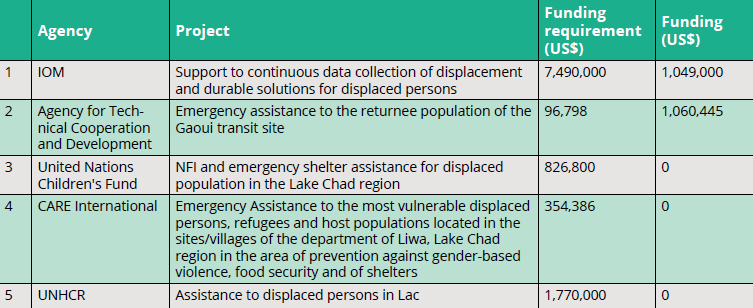Chad
Chad is the most underserved county in the Lake Chad Basin when it comes to humanitarian assistance.
Chad is one of the main refugee-hosting nations in Africa, accommodating refugees from the Central African Republic, Sudan and Nigeria fleeing regional conflict. By October 2017, there were approximately 620,000 people of concern in the country including refugees and internally displaced people (IDPs).
The landlocked nation experiences continued instability triggered by tensions between the nation’s ethnic groups, conflicts with neighboring states and consequences of climate change, particularly desertification contributing to the drying up of Lake Chad.
The need for adequate shelter is significant and continues to rise. Current shelter provisions for displaced groups are of a low standard. As a result they live in deprived conditions and are unprotected from extreme weather such as heavy rain.
Approximately 600,000 people are in need of Shelter/NFI/CCCM provisions, of which only 2,892 were reached in 2017.39 Chad has an HDI ranking of 186 out of 188. The international community should aim to assist the state in providing the majority of humanitarian responses as it may not have the ability or resources to do it itself.
Chad is one of four nations suffering from continued violence driven by Boko Haram.
This has resulted in high numbers of displaced people in the Lake Chad basin, affecting around 17 million people from Nigeria, Chad, Cameroon, and Niger.
The majority of the IDPs and refugees fleeing from the conflict can be found within the Lac region in the west of the country.
As of August 2017, the crisis has displaced a total of 127,268 people comprising of refugees, Chadian returnees and IDPs.
This figure accounts for just under 20% of the total number of displaced people in Chad. Families are torn apart and uprooted from their homes and livelihoods, leaving everything behind as they escape. They move to camps or to impoverished host communities in the Lac region and around 105,000 people required shelter and NFIs.
They do not have the resources to afford construction materials especially since these materials are already in low supply due to their location in the desert.
In 2017, according to the Financial Tracking Service (FTS), there were five agencies appealing for shelter projects in Chad.
According to the FTS, only 20% of the $10.5m funding required for shelter was achieved through planned appeals. The $2.1m was provided by 2 donors; the European Commission’s Humanitarian Aid and Civil Protection Department and the Government of Japan.
This funding was directed toward only two of the proposed projects (as displayed in the table above), neither of which were targeting the shelter needs for those suffering the Boko
Haram crisis in the Lac region. This has left at least 20% of Chad’s displaced populations shelter needs unmet through planned appeals.
A further problem can be identified when analyzing the projects that were to be funded in 2017. Whilst the five proposed projects seen above planned to address the needs of both those in the western Lac region and those suffering from the adversity in CAR relocating to Gaoui, there are groups in need of shelter in the country who have not been targeted.
There were no projects explicitly directed towards Sudanese refugees (who make up the largest proportion of refugees in the country), nor for Chadian returnees from Sudan, although they may have been incorporated into the IOM’s project.
Sudanese refugees may not have required shelter provision in 2017 because some have been in Chad for years due to the ongoing conflict in Darfur. However, due to the lack of data on emergency provision in previous years, the needs for shelter or repairs concerning wear and tear cannot be dismissed.

The planned appeals for the shelter needs in Chad for 2017 were severely underfunded by $8.4 million, leaving thousands of people without adequate shelter.
Insufficient funds were directed toward shelter and even less was raised.
Displaced persons from the Boko Haram crisis and people fleeing the conflict in Sudan were either not assisted due to lack of funding or were not even targeted.
This begs the question: how are they meeting their shelter needs without external assistance? Are there other international or state actors assisting them, or does the pressure rely on host communities to share their already scarce resources?
See page 18-20 of the report for details and references.

Chad is the most underserved county in the Lake Chad Basin when it comes to humanitarian assistance.
ShelterBox has been responding to the ongoing displacement occurring in the Lake Chad Basin of Africa – Cameroon, Chad, Niger and Nigeria. With your support, we have helped over 11,500 families.
The UN estimates that around 10.7 million people in the region are currently in need of relief aid, with just over 2 million displaced from their homes, either within their countries of origin or across borders into neighboring states.